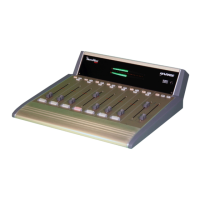Revision C • 12/05
HARRIS CORPORATION
2
Thanks for joining the growing family of broadcasters
employing Harris Corporation products designed by PR&E. Our
mission is to provide the finest quality products, systems, docu-
mentation and after-sale support. To this end, we invite com-
ments and suggestions for improvements to this documentation
or to any of our services.
To obtain maximum benefit, please read through this guide
prior to mixer installation.
STEREOMIXER® DIGITAL OVERVIEW
StereoMixer®
digital
(SMX
d
) is a compact mixer available
in two models: rack-mount and desktop. SMX
d
was designed
for single talent/board operator use in applications such as
voice tracking studios, production rooms, nonlinear editing
suites and newsrooms. It has the following features:
• Four analog inputs (one input is mono), with a front panel
TRS stereo jack for convenient field recorder connection
• Three AES-3 digital inputs (S/PDIF-compatible) with
integral sample rate converters on each input
• Two Program buses and one mix-minus bus with both
analog and digital outputs
• Stereo bargraph meter display of the two program buses,
an External Monitor Input, or Cue
• Analog room monitor output, external talk input, talk
output, headphone amplifier output for talent headphones
• Room monitor mute logic plus opto-isolated interface
logic for a hot mic warning interface, intercom talk, mic
remote panel control, channel start command outputs
and timer reset output
• Audio and logic signals use separate connectors with AMP
MOD IV crimp terminal connectors (as used on the
BMX
digital
and RMX
digital
consoles) or D-sub (logic only)
Input Features
The mixer has seven inputs/channels. Four are analog, three
are digital. Rear panel switches set each analog input to either
-10 dBv (unbalanced) or +4 dBu (balanced) operation.
Channel 1 is a mono line-level input designed for a pre-
amplified talent mic. It can alternately be set as a mono line
input. Channels 2, 3 and 4 are analog stereo line-level inputs.
Channels 2 and 3 can alternately be set as two additional mic
inputs from guest microphone preamps. Internal DIPswitches
(identified on page 9) set whether ch. 1, 2 and/or 3 are mic
inputs (which mute the monitor output) or line inputs.
Channel 4 is an analog stereo line-level input that features
a front panel TRS jack to allow easy plug-in of a field recorder
or DJ system (which is summed with a rear panel connector).
Channels 5, 6 and 7 are stereo AES-3 digital inputs with
integral sample rate conversion that accepts sample rates from
32 to 48 kHz.
Any one channel can be set as a Telco input from a phone
hybrid, ISDN or other 2-way communications device. The Telco
channel, set by internal DIPswitches (defined in Table 1 on
page 9), is always removed from the mix-minus output that is
returned to the Telco device.
Each of the seven input channels has these controls:
• Single channel On/Off button (lit by LEDs when On)
• Digital level control (linear faders on the desktop
version; rotary faders on the rack version)
• Function button (Talk on ch. 1, Cue on ch. 2 - 7)
• Program 1 and Program 2 bus assignment buttons
Output Features
The six analog outputs (+4 dBu balanced, -2 dBv unbal-
anced) are PGM 1, PGM 2, Room Monitor, Mix-Minus with
talk and Talk to External. The three digital outputs (PGM 1,
PGM 2, Mix-Minus) use a sample rate of 48 kHz (AES-3). An
amplified talent headphone output (1/4" TRS jack) has the
same monitor source as the Room Monitor output.
The Mix-Minus output is a sum of all the channels (post-
fader, post-switch) assigned to the same bus as the Telco chan-
nel—but minus the Telco channel audio. The mix-minus bus
is identified by the winking Telco bus assignment button. On
the left digital output and the analog output, talkback is added.
The digital right channel is a mix-minus without talk output.
Talkback audio is only active when channel 1 is set as a mic
input. Pressing the Talk button routes the mic—pre-switch
and pre-fader, to both the Talk output and to the Mix-Minus
with talk outputs.
Monitor Features
The monitor section has these controls:
• Monitor/meter source selectors (PGM 1, PGM 2, EXT)
• Digital level controls for the room monitor and talent
headphone outputs (linear faders on the desktop version;
rotary faders on the rack version)
The monitor outputs/meter can have four sources: Program
1, Program 2, an analog External Monitor input or Cue.
The Room Monitor and Headphones faders control the line-
level output for a pair of powered room monitor speakers and
General Information

